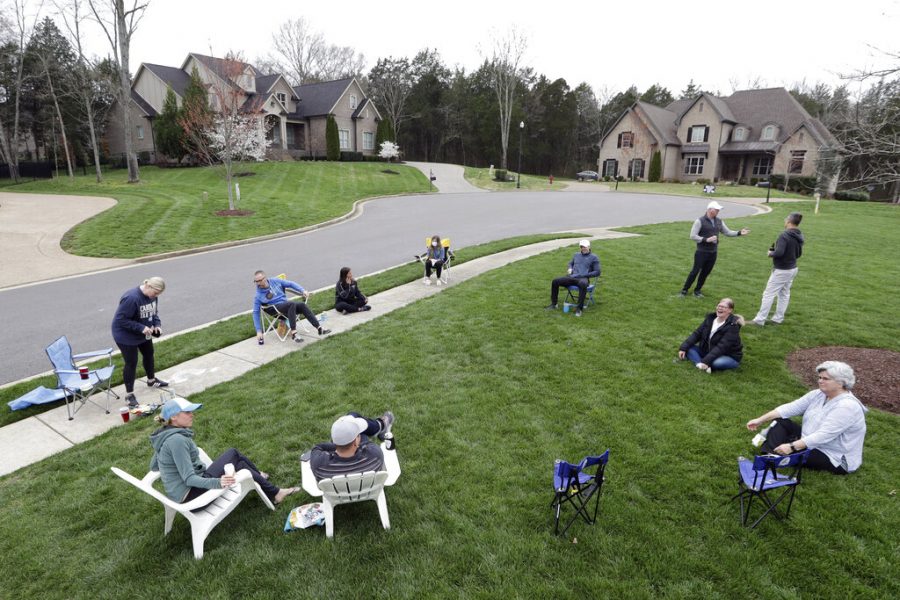A very different perspective on the first quarantine
Neighbors have an informal gathering while keeping a safe distance because of the corona virus Sunday, March 22, 2020, in Nolensville, Tenn. (AP Photo/Mark Humphrey)
It’s been a year since the very first 2-week quarantine in March, and even though life seems like it is slowly getting back to normal, whatever that means anymore, we need to embrace the values and realizations that we all learned during that time. Let’s not forget some of the good that came from those days.
It was the only time of their lives when it seemed like life was put on a pause. No classes to attend, work got canceled, and everything you could think of was closed except grocery stores. We couldn’t get food with friends at a restaurant and there weren’t even sporting events on the TV to enjoy.
And as we continue on to hear good news in relation to the race for normalcy, let’s never forget and take the lessons we learned from the time where all we had was nature, our neighbors, and a life of simplicity– for the ones not directly impacted by the virus. As the weather was getting warmer in the spring, people took the time to genuinely talk to each other every evening by setting up lawn chairs in the driveways. Let’s remember what it was like when people would go for a walk outside just to get their minds off the situation we were all in last year and still are to this day. But the difference then was, that it was new to us. One having to walk on the sidewalk and the other on the street, we all learned to make changes to figure out ways to continue having interactions with the ones we loved the most.
“My son was thirteen when it first started and we were like, ‘go play in the woods’ and he was like, ‘what?’ Two weeks later there he is building forts and riding bikes through the woods with his friends and so is his younger sister who was 11 at the time,” Dr. David Hall, NPHS Social Studies Teacher.
Instead of the kids of the neighborhood barely interacting with each other because of obligations like having to go from art class at 4, to soccer practice at 6, and then to basketball at 7:30– they were forced to interact with other kids outside. They truly got to experience what it was like to become neighborhood friends with one another. They started playing outside, riding bikes, and having fires in their backyards roasting marshmallows.
“I have a projector at home with an inflatable movie screen that we can put outside, and this was back when we were all scared to be close to each other outside, so I did a drive-in movie on my front lawn. Neighbors were allowed to come up and we all watched a Disney movie for the kids in the neighborhood,” Dr. Hall said.
Dr. Hall is one of the millions of stories around the nation of how people got creative in order of making the most with the hands we were all dealt with. From parents having to figure out something for their children to high school students learning what to do with all of the free time.
“The first lockdown really gave me time to work on myself and acknowledge the things I was taking for granted. My little sister and I became so much closer and I spent more time really communicating with friends. I also realized how much I like being AT school and overall, I learned to appreciate everyday life more,” North Penn Junior, Brooke Baitinger said.
Another thing to take into account was the relieving pressure on students’ mental health. I say that because that break from school was totally different than going on spring break for example. Because at the start of spring break, there is always the reality of getting homework assigned or having to allocate a little bit of time to studying for a test that will take place when you come back from break. The two-week quarantine, however, didn’t necessarily mean anything. No work was or could be assigned and any test that was scheduled beforehand had to be pushed back because of how much work was missed should we return. And we all know that didn’t happen.
“Before quarantine, I was always wishing for time to stop. For the first time ever, it came true. I was able to breathe and take a break from all the responsibilities and chaos I had going on. It helped restore my mental health. I also learned family does fill the heart and I felt as if we were little kids again having no sense of time. My family and I would even often spend nights playing monopoly three until 4 am,” North Penn senior Sabina Parra said.
It seems as if it is common action to look at a situation and just point out the bad things that come from it. For mental health purposes, it’s best for one to take a situation, and try to figure out if there are any positives from it. And if there are none, create your own. But above all, no matter how bad things may seem like, in the words of Louis Armstrong: the trees are green, roses are blooming, the sky is blue, and the clouds are white.
“I’ve enjoyed a lot of this– I have. Here’s what I believe, there are few changes in life that ever turn out to be all bad. I would never ask for this pandemic to happen, I would never welcome it. Did it create some hardship and pain that seems grossly unfair and difficult to manage? It did. But did it create some things that I’ll cherish for the rest of my life? It did that too,” Dr. Hall concluded.


